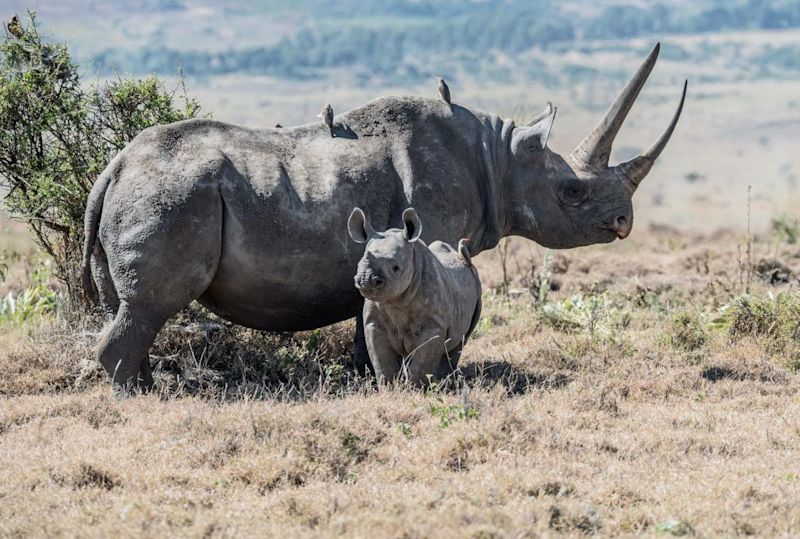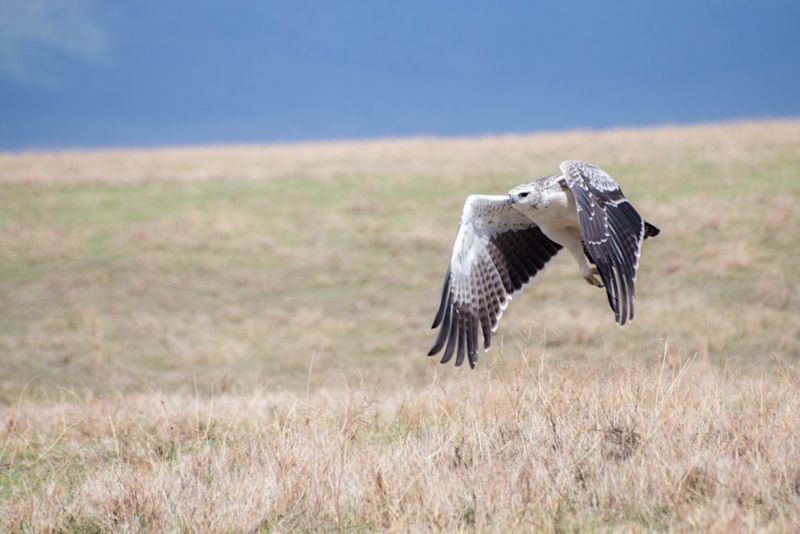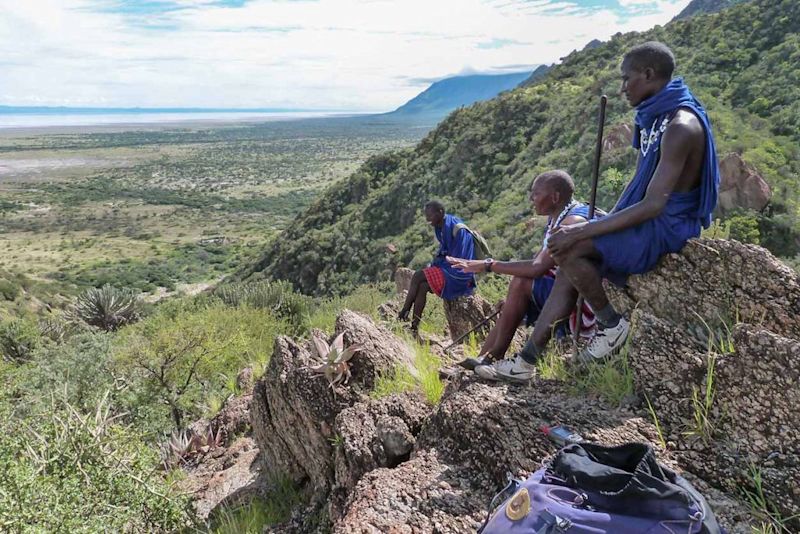Various beautiful habitats from forest to grasslands fill Ngorongoro Crater and provide homes for hundreds of species of animals and birds. A dirt road that snakes down into the crater and stretches across the basin floor allows visitors to go on safari drives through this spectacular landscape and see a breathtaking abundance of wildlife.
There's so much to know and shake your head in wonder over when it comes to this special and unique place. So we've put together this list of 12 great facts about Tanzania's Ngorongoro Crater that we think you'll really enjoy reading!
1. The largest unbroken caldera in the world
Visitors are only allowed to explore Ngorongoro Crater in a safari vehicle
Once upon a time Ngorongoro was a volcano. Then it collapsed, creating a bowl-like depression known as a caldera. The word caldera comes from the Spanish word for ‘cooking pot’. Because yes, a caldera is a pot-like depression.
A caldera is a specific kind of crater – one caused when a volcano mouth collapses in on itself.
Of the hundreds of calderas around the world, Ngorongoro Crater is the largest unbroken one. What we mean when we say ‘unbroken’ is that no part of the crater wall has been breached. So Ngorongoro Crater consists of a beautifully in-tact wall. Ngorongoro Crater is almost 20 km wide and covers 264 km².
2. Viewed from the rim, the crater looks empty
From the rim of Ngorongoro Crater, the basin floor looks empty – but that's only because you're too high to see the abundant wildlife spread out everywhere!
The wall of Ngorongoro Crater rises about 600 m above its floor. That’s about 180 storeys, or three Gateway Arches stacked on top of each other!
Another way to give you a sense of the enormity of the crater is this: when you stand on the rim and look down, you see what appears to be a vast and empty expanse, with simply a lake, a few streams and marshlands, and a small forest. Yet in reality Ngorongoro Crater is teeming with wildlife, including giants like elephants. You’re just too far away to see them!
A whopping 25,000 to 30,000 large mammals live in Ngorongoro Crater.
It’s only as you start winding down the zigzag-y descent road into the crater that you start to see how littered with animals the base of the crater actually is! Once you reach the crater floor, you discover that animals are everywhere!
3. The crater has several different ecosystems
A view of Ngorongoro Crater's Lake Magadi and Lerai Forest
Ngorongoro Crater has a wonderfully large range of habitats able to support a vast array of wildlife. Some of its most prominent ecosystems are as follows:
- The steep and forested crater wall. This wall of Ngorongoro Crater is mostly covered in thick montane forest, with the shallower western wall being dominated by euphorbias. The wall's forest is a favourite haunt for leopards, so be sure to look for them when driving down and back up out of the crater.
- The alkaline and seasonal salt Lake Magadi and its surrounding soda flats. These are home to many waterbirds, including greater and lesser flamingos.
- Mandusi and Gorigor Swamps. They’re a sanctuary for elephants, hippos, lions, other mammals big and small, and all sorts of waterbirds.
- Hippo Pool. Located on the edge of Gorigor Swamp, this is a popular picnic site among safari-goers.
- Lerai Forest. This is a small woodland comprising primarily acacia and yellow fever trees, and is popular with monkeys, baboons, elephants and Fischer’s lovebirds.
- Extensive grasslands. These are populated with large numbers of lions, elands, wildebeests, plains zebras, black rhinos, spotted hyenas, and more.
While most head to Ngorongoro Crater for a safari drive, you can actually go on guided walks in the wall's forest, where you see waterfalls, rare and colourful birds, and amazing views of the crater basin below.
An elephant herd near the thickly forested wall of Ngorongoro Crater
When to visit
Depending of the time of year, you're likely to either look down from the crater rim on a green, flourishing basin, or a dry, scorched one.
The seasons are (roughly speaking):
- Short dry season: January to mid March
- Long wet season: mid March to May
- Long dry season: June to October (most popular season)
- Short wet season: November and December
One of the perks of visiting in one of the dry seasons is that animals are easier to spot at such times, as there's less vegetation to hide them. They're also forced to congregate around diminishing water supplies, so you know exactly where to find them. The long dry season is also favourable for being a bit cooler during the day. Conditions can get pretty hot and sticky at the beginning of the year.
The perks of visiting in one of the wet seasons is the beautiful, softening effects of the long grass, green foliage and veld flowers. Tourist numbers are also much lower.
You can learn more detail to help you decide when is the right month for you in Best time of year for an Ngorongoro Crater safari.
4. Ngorongoro Crater boasts 300 animal species
Zebras, hyenas and gazelles in the grasslands of Ngorongoro Crater
Ngorongoro Crater is home to many wonderful and important animal species. Moreover, it has an incredible density of these creatures, so it’s a fantastic place to see many wild animals in a short span of time. Because it’s so steep, the wall has served as a semi-barrier to the outside world. Both humans and certain animals have a hard time descending the steep wall to reach the plains and hills of the basin. This has allowed the crater to become a true sanctuary for all sorts of wildlife.
Some of the animals living in Ngorongoro Crater are very important – and exciting to spot – because they are globally threatened species. We’re thinking here of animals like:
- Black rhinos – they’re critically endangered, as there are only around 5,000 left
- African golden cats – they’re listed by the IUCN as vulnerable
- African wild dogs (or painted dogs) – these beautiful carnivores are endangered
Black rhinos are easy to identify because of their hooked upper lip, made to help them eat leaves
The most popular game
Some of the other animals to look for while on an Ngorongoro Crater safari are:
- Lions
- Bush elephants
- Spotted hyenas
- Serval and caracal cats
- African civets
- Black-headed and golden jackals
- Bat-eared foxes
- Cheetahs
- Leopards
- African buffaloes
- Blue wildebeests
- Burchell's zebras
- Grant's and Thomson's gazelles
- Coke's hartebeests
- Bushbucks
- Elands
- Defasse waterbucks
- Vervet monkeys
- Olive baboons
- Hippos
Certain of the animals live year round in the crater, while other species migrate in and out of the crater with the seasons. For instance, about half of the crater’s zebras and a small portion of the wildebeest population leave the crater during the rainy season. And it’s during this time that the crater’s eland and buffalo numbers increase.
5. The crater has the Big Five, but no giraffes
An elephant, an egret and two grey crowned cranes in one of the marshlands of Ngorongoro Crater
Relatively few African countries and game parks can lay claim to having all of the Big Five, namely bush elephants, Cape buffaloes, leopards, lions and black rhinos.
One of the key reasons for this is the critically endangered nature of black rhinos. In the past two centuries black rhinos have been hunted to near extinction, and the remaining populations require constant protection from poachers.
For a ‘small’ space like Ngorongoro Crater to be able to claim populations of all of the Big Five is therefore very impressive indeed. (You might be interested to find out which animals some people say should make up the NEW Big Five.)
A mother and calf head into the forest along one of the game roads
Giraffes live in the area, just not the crater
Most parks that have the Big Five are expansive places like the Serengeti, which can also boast the usual range of accompanying large game, like zebras, hippos, wildebeests, giraffes, cheetahs and so on. So it’s interesting to note that while Ngorongoro Crater does have the usual mix of large animals and the Big Five, giraffes are notably absent.
Towers (groups) of giraffes are found in healthy numbers elsewhere in the Ngorongoro Conservation Area (NCA), but none live or have been seen in the crater. It’s been speculated that the reason giraffes haven’t made it into the crater ecosystem is that the walls are probably too steep for them to descend.
Two other creatures besides the giraffe that you might expect to find but are missing from the crater's roster are the crocodile and impala.
6. It has the world's highest density of lions
Your chances of spotting lions on an Ngorongoro Crater safari are the highest of anywhere in the world
If you really want to see lions, you need to organise yourself an Ngorongoro Crater safari! It has – hands down – the highest lion population of anywhere in the world.
According to KopeLion, there were 65 to 75 lions in Ngorongoro Crater in August 2020, divided into eight prides. That’s a tremendous number for an area of just 264 km². It works out at one lion for every 3.7 km².
For the sake of comparison, nearby Serengeti National Park, which is known the world over for its rich abundance of wildlife, has one lion for every 5 km². And South Africa’s famous Kruger National Park – also a great destination for lion-spotting – only has one lion for every 12 km².
7. Its lions are the world's best-studied population
Some of Ngorongoro Crater's lion prides consist of just two or three lionesses
Over the past few decades, researchers have been actively studying the lions living in Ngorongoro Crater. There are fewer than a hundred lions living in the crater, and given the relatively small domain of the Ngorongoro Crater lions, scientists have been able to track and monitor these lions extensively. So much so, that the crater's lions are the most studied lion population in the world!
Each of the eight prides currently living in the crater has been given name. Many of the individual lions have been named as well.
Interesting fact: female lions have been proved to be more attracted to males with dark manes than to males with blonder manes!
Study has shown that the majority of the lions in Ngorongoro Crater were born there, remained there throughout their lives, and die there. Occasionally a roaming male will enter the crater – some stay permanently, while others eventually move on. This has led to a rather incestuous lion population, with males mating with aunts, sisters and even mothers, daughters and granddaughters.
8. Over 550 species of birds can be seen here
A lone ostrich presents a rather contemplative pose in the browned dry-season grass of Ngorongoro Crater
Ngorongoro Crater plays host to over 550 different species of birds. That’s mind-blowing when you really think about it. While it’s an enormous crater – one of the world’s largest – it’s crazy that you can see that many birds within its walls and airspace.
A real drawcard of Ngorongoro Crater is that it allows you to see many rare, beautiful, migrant and endemic birds in a short space of time.
There are many raptors to be seen in and around the crater, including eagles, buzzards, hawks, kites and vultures. Other types of birds in the crater include greater and lesser flamingoes, swans, storks, pelicans, geese, plovers, teal, gallinules, pheasants, plovers, lapwings, spurfowls, sparrows, larks, wheatears, pipits, cranes, bustards, coots and rails.
If you’re keen to see the migrant bird species that visit the crater, then you want to plan your trip sometime between September and April. Migrant birds to be spotted include Montagu’s harriers, pallid harriers, lesser kestrels, European swallows, European bee-eaters, European rollers, Caspian lapwings, and northern wheatears.
A gorgeous martial eagle | Image by A. Berger
Cool fact: the Egyptian vulture knows how to hold a stone in its beak and use it like a little hammer to crack open ostrich eggs!
Some of the most exciting birds
A few Ngorongoro Crater birds in particular to look out for are:
- Augur buzzard
- Egyptian vulture
- Black kite
- Martial eagle
- Secretary bird
- Kori bustard
- Hildebrandt’s spurfowl
- Hildebrandt’s starling
- Hildebrandt’s francolin
- Hottentot and blue-billed teals
- Black crake
- Kittlitz plover
- Rufous-tailed weaver
- Grey crowned crane
- Adbim’s stork
- Green wood hoopoe
- Fischer’s lovebird
- Rosy-throated longclaw
- Black-winged lapwing
- Kenya rufous sparrow
9. Three discrete tribes have historic roots here
Three Maasai men overlook Lake Eyasi in the Ngorongoro Conservation Area | Image used with permission from KopeLion
The Ngorongoro Conservation Area (NCA) is a multipurpose reserve. While the communities living in the NCA cannot engage in agriculture, they’re allowed to live there and rear livestock. Nobody, however, is allowed to settle in the crater.
Three people groups live in the NCA:
- Maasai – 98% of the resident population
- Datooga – 2% of the resident population
- Hadza – Only a handful of families living near Lake Eyasi
There are over 40,000 Maasai tribes people living in the Ngorongoro Conservation Area. They are, however, relative newcomers to the region. The Datooga lived in the area long before the Maasai started arriving in the 1700s and pushing them out.
On the western shore of Lake Magadi in Ngorongoro Crater are very old stone burial mounds believed to belong to the Datooga people.
The Hadza are believed to be descendants of Tanzania's oldest inhabitants, and to have lived in the region for thousands of years. Their language – Hadzane – is thought to be an isolate, meaning it has no known connections to any other languages.
10. It's a natural and cultural World Heritage Site
Hippos are a staple of the marshland ecosystem in Ngorongoro Crater
The Ngorongoro Conservation Area (NCA), which is 8,094 km² and encompasses Ngorongoro Crater, is a Mixed Cultural and Heritage UNESCO World Heritage Site. It earned this status for a few reasons:
- The presence of globally threatened species (like the black rhino, wild hunting dog and golden cat) and the need to protect them.
- The fact that the NCA has the highest density of mammalian predators in Africa and the desire to protect them.
- The incredible density of wildlife within the NCA’s borders in general, including over 500 bird species, and the importance of conserving them and their habitat.
- The presence of the Great Wildlife Migration herds at certain times of the year in the northwest of the NCA.
- The stunning landscape of the NCA, particularly that of Ngorongoro Crater and Olduvai Gorge.
- The incredible archaeological importance of the NCA – and Olduvai Gorge in particular – in terms of human evolution, stone technology, and human–environment development.
11. A third of all Tanzania tourists visit the crater
Kazi (left) is our Tanzania safari guide – he loves taking visitors to Ngorongoro Crater, which of course begins with a stop at a lookout point like this one!
Around 450,000 people visit Ngorongoro in a (non-pandemic) year. That’s over a third of all visitors to Tanzania according to the latest stats. What smart cookies these folks are. This makes Ngorongoro one of the top tourist attractions in all of Tanzania, alongside the likes of Mt Kilimanjaro, the Serengeti, and the beaches of Zanzibar.
If you're feeling inclined to join the ranks of the smart people who make smart travel choices, please take a look at our Tanzania safari itinerary – it includes Ngorongoro Crater and Olduvai Gorge, as well as the Serengeti and other fantastic parks in the area. We also now take folks to see the otherworldly Lake Natron, Tanzania's remote, beautiful and poisonous red lake on our hiking and safari itinerary.
12. The name Ngorongoro is onomatopoeic
Maasai children wearing traditional attire – the girls' large, flat, beaded collars identify their clan and social status
The name Ngorongoro is believed to have been coined by the Maasai and based on the sound made by a jingle bell tied to the neck of the boss cow in a herd. The thought was that the cow bell makes an 'ngor-ngor' sound, hence the name Ngorongoro. Using reduplication in the formation of words denoting something that has a repetitive nature is a common practice in Bantu languages, as in many other language groups.

























